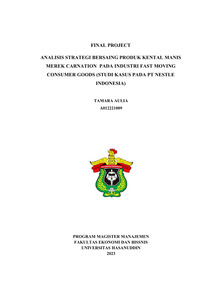Aulia, Tamara (2024) ANALISIS STRATEGI BERSAING PRODUK KENTAL MANIS MEREK CARNATION PADA INDUSTRI FAST MOVING CONSUMER GOODS (STUDI KASUS PADA PT NESTLE INDONESIA). Thesis thesis, Universitas Hasanuddin.
![[thumbnail of Cover]](/36419/1.hassmallThumbnailVersion/A012221009_tesis_14-05-2024%20cover1.png)

A012221009_tesis_14-05-2024 cover1.png
Download (157kB) | Preview
A012221009_tesis_14-05-2024 1-2.pdf
Download (707kB)
A012221009_tesis_14-05-2024 dp.pdf
Download (73kB)
A012221009_tesis_14-05-2024.pdf
Restricted to Repository staff only until 1 January 2026.
Download (1MB)
Abstract (Abstrak)
With the increasing fierce of business competition, it raises many new problems that should be faced by companies. This forces companies to be able to survive in facing various challenges in a great competition. Similarly, the problem is also faced by Carnation brand products, a sweet condensed product originating from PT Nestle Indonesia. Along with technological advancements, information, equipment, and knowledge are easily obtained by anyone. This is an opportunity to develop the market, but it is also a threat of the entry of new competitors who provide products at very low prices. The new wave of competitors is a problem for Carnation brand products to expand their business. If this situation is left unchecked it will harm the company. To overcome this threat, the writer analyzes internal and external factors affecting the business and creates new business strategies using SWOT analysis. The resulting strategies are product development, market development, human resource development, and promotional development that can be used by Carnation brand products to overcome competitor threats.
| Item Type: | Thesis (Thesis) |
|---|---|
| Uncontrolled Keywords: | business strategy, analysis SWOT, new entrances, fast moving consumer goods |
| Subjects: | H Social Sciences > HD Industries. Land use. Labor > HD28 Management. Industrial Management |
| Divisions (Program Studi): | Fakultas Ekonomi > Manajemen |
| Depositing User: | S.I.P Zohrah Djohan |
| Date Deposited: | 29 Aug 2024 00:34 |
| Last Modified: | 29 Aug 2024 00:34 |
| URI: | http://repository.unhas.ac.id:443/id/eprint/36419 |


